
By Silvia Lucero

Leaders in Energy and the Association of Energy Engineers National Capital Chapter (nonprofit organizations located in the greater Washington, DC Metropolitan area) conducted their Sixth Clean Energy & Sustainability Extravaganza at the University of Maryland-College Park on February 28th, 2020. The University Showcase Panel focused on clean energy and sustainability initiatives taking place on campuses that can also find wider application in communities and personal lifestyles to move us toward a greener world.
Shown in photo l-r: Pat Fox and Drew Nixon (UMD students), Marta Voldu (UMD Department of Transportation), Guy Kilpatric (UMD Terp Farm), Tanvi Gadhia (UMD Office of Sustainability), Greg Farley (George Mason University Director of University Sustainability), and Moderator, Dr. Elvin Yuzugullu, Project Manager, General Dynamics Information Technology (GDIT), Adjunct Professor at The George Washington University’s Engineering Management and Systems Engineering Department, Leaders in Energy Zero Waste Coordinator, (Photo Credit: Michelle Jaffe).
Overview
The speakers provided different perspectives on initiatives taking place in sustainability at the university level. These include developing new technology, utilizing campuses as living laboratories, shifting behavior to make sustainability more of a cultural and social norm, reducing greenhouse gas emissions, including sustainability into curriculum, as well as the application of student sustainability funds for campus initiatives.

The U of Maryland (UMD) is developing its campus as a living laboratory to monitor its energy and water use through an energy dashboard program, energy audits, and stormwater management. Under their Smart Commute initiative, UMD offers a Parking Cash Out program that pays people to give up their parking to encourage more transit, bike, carpool, and walk commuting.
Both George Mason University (GMU) and UMD, are making significant strides in reducing greenhouse gas emissions. GMU has purchased 46 million kilowatt hours of renewable electricity in addition to other initiatives. The UMD has a Climate Action Plan 2.0 with 38 strategies to save an estimated $120 million and cut C02 by 4.3 million tons from 2016 to 2040. Students talked about their work in wind and kite energy research. This includes a goal to establish a well-funded research group to develop a kite wind energy testbed system at UMD. The Terp Farm has been collaborating with the UMD campus food system to increase annual sustainable foods purchases (meeting the criteria identified for sustainable food categories including local, fair, humane, and ecologically sound) by 1-4%.
Learn more below about the key elements that were highlighted by the panel speakers. Presentations are available at Leaders in Energy’s Event Archives.
Greg Farley, Director of University Sustainability, George Mason University in Fairfax, VA

Mr. Farley began by providing an overview of George Mason’s sustainability initiatives. The University received an ASHRAE Gold rating, one of only 120 schools that have attained that rating nationwide. George Mason offers over 125 courses that are sustainability themed or focused. Mason’s Greenhouse and Gardens produced over $33,000 worth of produce including micro-greens and tomatoes that are used by the campus kitchen and dining halls. The Patriot Green Fund asks students to brainstorm solutions to campus sustainability needs and then funds both the research and execution of those ideas. Recently, George Mason achieved a R1 status (high levels of research activity) and has a goal to achieve carbon neutrality by 2050.
Mr. Farley began by providing an overview of George Mason’s sustainability initiatives. The University received an ASHRAE Gold rating, one of only 120 schools that have attained that rating nationwide. George Mason offers over 125 courses that are sustainability themed or focused. Mason’s Greenhouse and Gardens produced over $33,000 worth of produce including micro-greens and tomatoes that are used by the campus kitchen and dining halls. The Patriot Green Fund asks students to brainstorm solutions to campus sustainability needs and then funds both the research and execution of those ideas. Recently, George Mason achieved a R1 status (high levels of research activity) and has a goal to achieve carbon neutrality by 2050.
Tanvi Gadhia, Sustainability Outreach Coordinator, University of Maryland
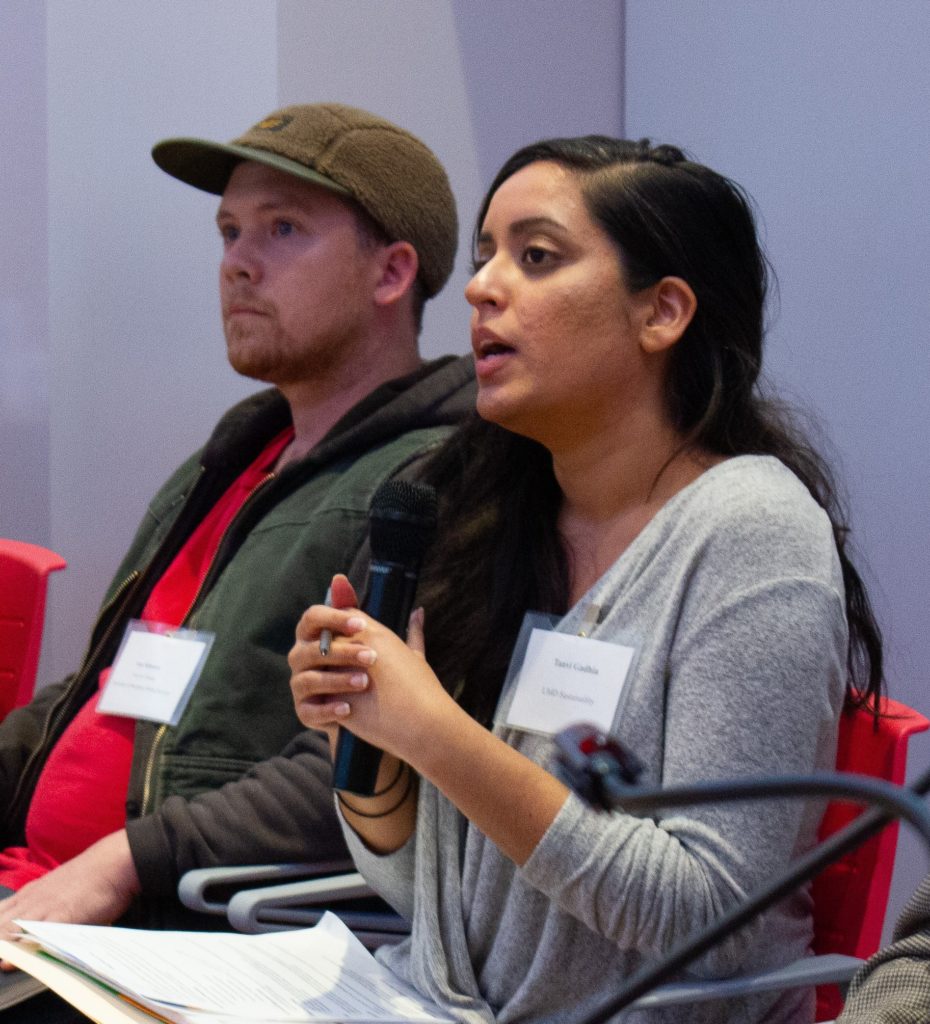
Ms. Gadhia began as the University’s Sustainability Outreach Coordinator in April 2019. The University of Maryland has reduced carbon emissions by 50% and has a goal to get to carbon neutrality by 2050 with the hope to achieve this goal by 2025. Their Climate Action plan is updated every 5 years to identify the sources of the University’s green house gases and identify ways to reduce costs since many of their carbon reductions came from purchasing power agreements, renewable energy credits, as well as others. The University of Maryland generates renewable energy on campus with solar panels and has also started offsetting their air travel, a major source of their carbon footprint, and is the first major university to get 100% of their air travel offset. The University, using their Sustainability Fund, which is similar to George Mason’s fund, has also invested in unique solutions such as a swimming pool that is actually filtered with moss rather than chlorine. They have partnered with other groups like Maryland Sustainability Engineering to implement a storm water restoration project converting a concrete channel into a vegetative storm water retention facility. Students and faculty from the Center for Sustainability in the Built Environment created an energy dashboard allowing anyone on campus to view energy usage per building.
Ms. Gadhia’s outreach efforts primarily focus on changing students’ behavior by making sustainability a cultural and social norm. Her “Train the Trainer” program promotes sustainability and advises students to make sustainability one of their key values. Finally, the University’s Teaching Fellows program conducts a workshop for faculty to help integrate a sustainability focus in any course in any discipline. The UMD Sustainability Fund provides funding for projects that promote environmental sustainability, and positively impact and enhance the student experience at UMD. The Fund is supported by student fees and administered through a student-majority committee of the University Sustainability Council. More than 137 projects have received more than $2 million in Sustainability Fund grants since 2011.
Guy Kilpatric, Lead Agricultural Technician, UMD Terp Farm, a partnership with UMD’s Department of Dining Services, College of Agriculture and Natural Resources (AGNR) and Office of Sustainability

In 2012, University of Maryland Dining Services committed to providing more sustainable food to its students. Dining services began procuring more sustainable food sources and developed a sustainable food action plan to achieve their sustainability goals. Originally setting a goal of 20% sustainable food purchases by 2020, they actually achieved this goal in 2017. Since 2017, they joined the Menus of Change collaborative, which is focused on integrating optimal nutrition and public health, environmental stewardship and restoration, and social responsibility. The University of Maryland was the first university to sign the Cool Food Pledge, an initiative to offer diners more of the food they want while reducing food-related greenhouse gas emissions. All of these efforts have changed student eating and dining purchase habits towards more sustainable food.

Dining Services received a $124,000 grant from the Sustainability Fund for a 3 year pilot to start the Terp Farm with the triple bottom line of increasing economic, social and environmental impact. The Terp Farm is self-supporting (meeting its economic goal), donates 2 to 5 percent of its produce to campus and local food pantries (satisfying its social mandate), and is focused on soil health, resource conservation and producing local food (achieving its environmental goal).
Marta Woldu, Sustainable Transportation and Bicycle Coordinator at the University of Maryland Department of Transportation Services (DOTS)
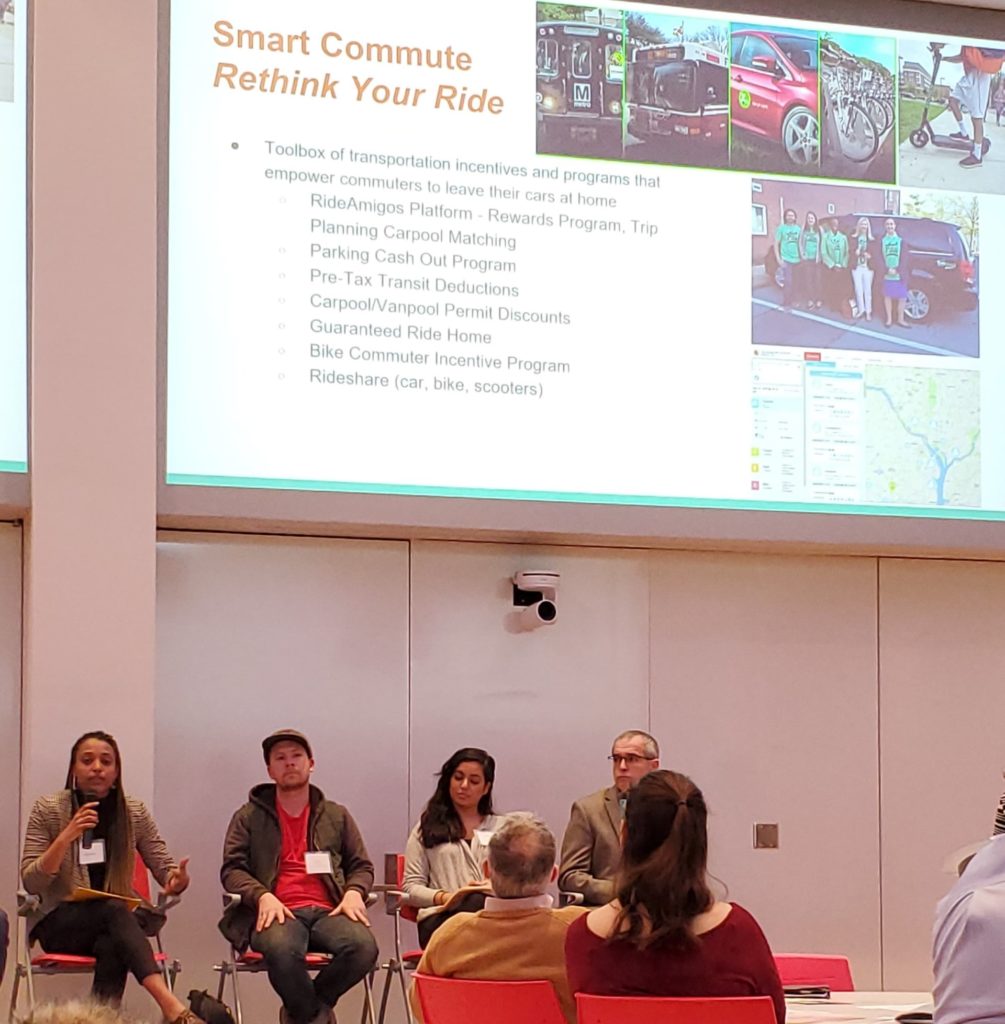
Ms. Woldu’s focus is on developing and implementing sustainable transportation strategies and re-evaluates their plan every 5 years. The construction of the Purple Line in Maryland will create opportunities for commuting offset goals. Sustainable Transportation also focuses on changing behaviors to align with campus sustainable goals. The Smart Commute program provides a variety of choices and incentives to help students rethink their commute options. They have a dashboard that provides rewards for all sustainable trips logged, trip planning and more. The Parking Cash Out program, which provides cash to employees who give up their parking and commit to a sustainable commute, started last year and has been successful. While commute times might be longer, employees encounter less stress and make better use of their commute time. Finally, Sustainable Transportation supports many campus initiatives including a shuttle service with 25 commuter routes; bike parking and student run bike shop; a bike and scooter share program; investigating the use of electrical buses; and solar panels on three of their garages.
Student Research Initiatives, Pat Fox and Andrew J. Nixon
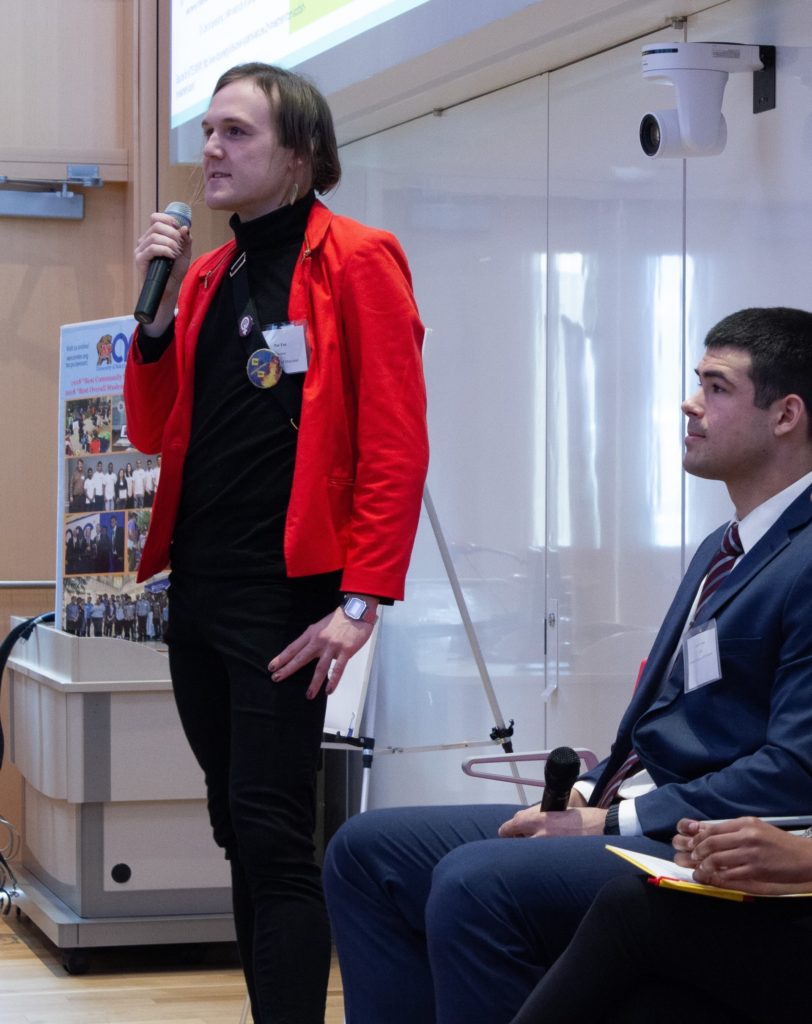
The Student Research Initiatives program was represented by Andrew J. Nixon, (sitting in photo) a sophomore electrical engineer major from a student lead group called, “Wind Turbines”. Their team is made up of University of Maryland engineering students from every engineering major as well as the Smith Business School. The Generator Team, whose purpose is to research wind energy, is creating a generator for future competition and will be competing in the U.S. Department of Energy’s Collegiate Wind Competition, the largest wind energy competition in the United States. In this competition, the team will be tested on the technical aspects of the wind turbine and how well can they plan a hypothetical wind farm.
Pat Fox (standing on photo) is leading the University of Maryland Kite Energy Project. Kite energy focused on airborne wind energy generated using kites to serve like wind turbines. Here is a video description of how an airborne wind energy system functions (from KPS in Scotland). Energy is produced on the ground by spooling a long cable flying crosswind (perpendicular to the wind) and then generating power by having the cable run a generator.
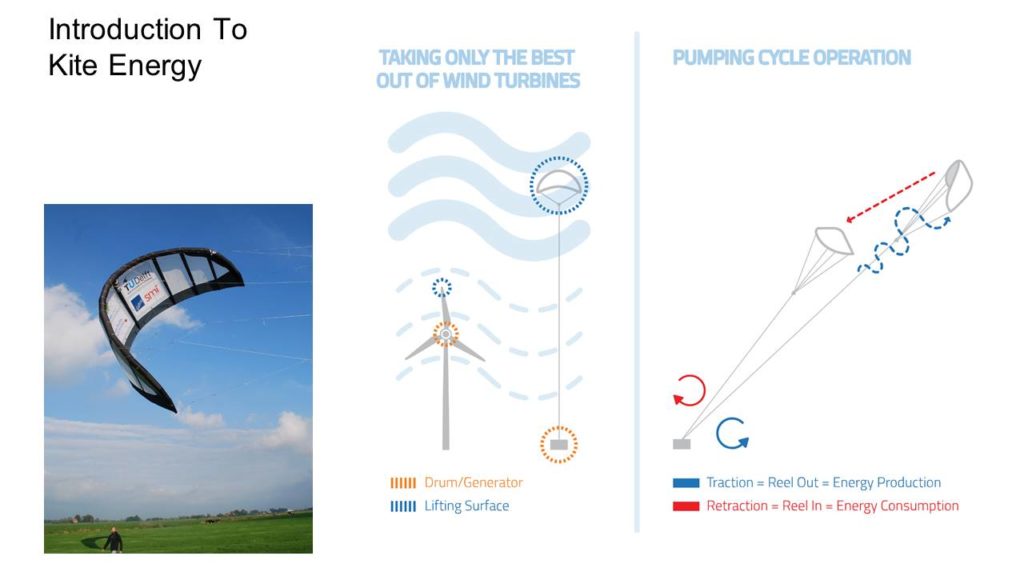
The Kite Energy Project, funded by the Sustainability Fund, is collaborating with researchers around the world including Brazil, Germany, Spain, and especially in the Netherlands. A major benefit of kite energy technology is that material costs are much less than a wind turbine – it doesn’t require a pillar supporting the entire system. Pat and other engineering students are building a small prototype system with a robotic controller box that will be able to autonomously control a kite boarding kite as well as a winch that will be able to electrically extend and bring back the kite.
Concluding Thoughts
It is very encouraging to see how sustainability and innovation are being embedded into the value and culture of these universities through a variety of mechanisms. These include the creation of a fund from student fees to research and create new technologies to continue improving their sustainability efforts.
Author: Silvia Lucero is an University Outreach Adviser for Leaders in Energy and serves on the board of EcoAction Arlington.
Photo credits: Alisha Comecho, Janine Finnell, and Michelle Jaffe.


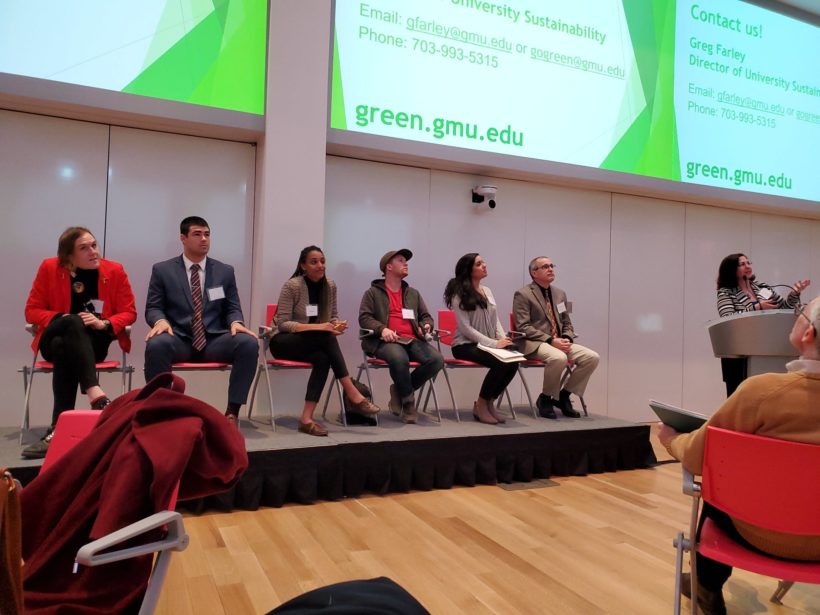
Leave a Reply